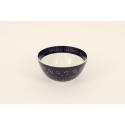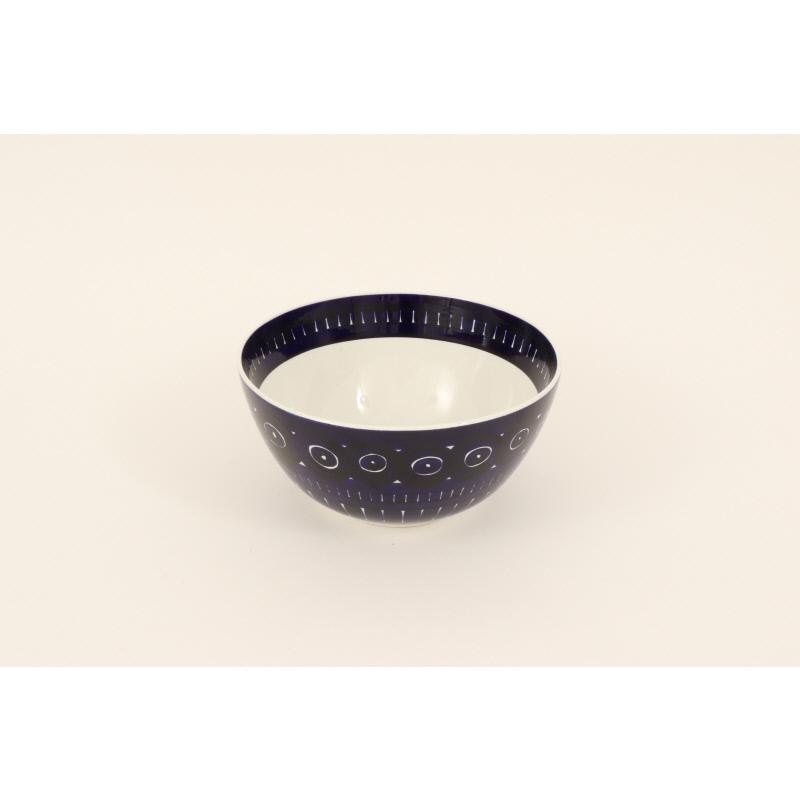Currently indexing
Bowl
Classification(s):
Pottery
Date: c. 1951-1976
Organisation: Arabia (Finland, founded 1873)
Designer: Ulla Procopé-Nyman (Finnish, 1921 - 1968)
Dimensions:
115 × 220 mm (11.5 × 22 cm)
Medium: Stoneware
Object number: P271C
See Also
Place of Production:Finland
Title:Valencia
DescriptionGlazed stoneware serving bowl by Arabia. Manufactured in Finland. The design is by Ulla Procopé and is from the ‘Valencia’ range. The bowl is hand painted in midnight blue; there are 2 bands of vertical lines around the body of the bowl, topped with a band of concentric circles. There is another band of vertical lines to the interior of the bowl. The ‘Valencia’ range was produced in the 1960’s, with a small portion of the range continuing to be produced until 2002.
Gold sticker to inside “Arabia”. Potters mark “UP” to base. The manufacturers mark is to the base.
Gold sticker to inside “Arabia”. Potters mark “UP” to base. The manufacturers mark is to the base.
ProvenanceThis object was originally acquired for the Inner London Education Authority’s (ILEA) ‘Circulating Design Scheme’ collection.
The collection was instigated by the London Country Council (later the Greater London Council) and the Council of Industrial Design (COID). The collection’s original purpose was concerned with the teaching and dissemination of modern, ‘good design’.
The collection was established in 1951/52 as the ‘Experiment in Design Appreciation’, later renamed the ‘Circulating Design Scheme’.
The Circulating Design Scheme lent boxed showcases to London schools. The showcases contained handling objects, material samples and interpretation on a specific subject.
COID withdrew its involvement in the Scheme in 1957. After which time, it was managed exclusively by the London County Council from 1957-1963.
After the administrative restructuring of London authorities, the Scheme was jointly managed by the Greater London Council and the Inner London Education Authority (ILEA) from 1963 – 1976.
The Scheme was operational until 1976 when the collections were withdrawn from circulation. ILEA was abolished in the late 1980s and the collection was donated to Camberwell College of Arts in 1989/90.
ILEA was responsible for secondary and tertiary education in the inner London boroughs, this included Camberwell.
The collection was instigated by the London Country Council (later the Greater London Council) and the Council of Industrial Design (COID). The collection’s original purpose was concerned with the teaching and dissemination of modern, ‘good design’.
The collection was established in 1951/52 as the ‘Experiment in Design Appreciation’, later renamed the ‘Circulating Design Scheme’.
The Circulating Design Scheme lent boxed showcases to London schools. The showcases contained handling objects, material samples and interpretation on a specific subject.
COID withdrew its involvement in the Scheme in 1957. After which time, it was managed exclusively by the London County Council from 1957-1963.
After the administrative restructuring of London authorities, the Scheme was jointly managed by the Greater London Council and the Inner London Education Authority (ILEA) from 1963 – 1976.
The Scheme was operational until 1976 when the collections were withdrawn from circulation. ILEA was abolished in the late 1980s and the collection was donated to Camberwell College of Arts in 1989/90.
ILEA was responsible for secondary and tertiary education in the inner London boroughs, this included Camberwell.
NotesHaving studied ceramics at the Central School of Arts and Crafts, Ulla Procopé went on to work for Arabia from 1948 to 1968. Initially Procopé hand-decorated Arabia ceramics, but later she moved to the product design department. Prokop’s most famous work is the practical fireproof ‘Liekki’ (flame) casserole series, she also designed the versatile ‘Ruska’ range of tableware and cookware and the ‘Rosmarin’ tea service pattern. In the 1950s the idea of 'oven to tableware' emerged, like many other manufacturers Arabia introduced specially designed dishes which were oven-proof and made of a high temperature resistant material. Importantly, the dishes were both functional and beautiful enough not to look out of place on a dinner service.






